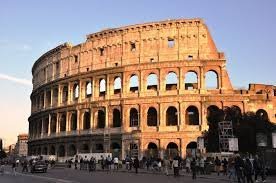The Roman Colosseum, also known as the Flavian Amphitheater, is one of the most famous landmarks in the world. Located in Rome, Italy, this architectural masterpiece stands as a symbol of the grandeur and power of the Roman Empire. With a rich history spanning nearly 2,000 years, the Colosseum remains an enduring testament to Roman engineering, entertainment, and cultural heritage. In this article, we explore its history, construction, significance, and interesting facts.
The History of the Roman Colosseum
The construction of the Colosseum began in AD 72 under the reign of Emperor Vespasian of the Flavian dynasty and was completed in AD 80 by his son, Emperor Titus. The Colosseum was built to host grand spectacles such as gladiator contests, animal hunts, and public executions.
For centuries, it remained the center of Roman entertainment. However, after the fall of the Roman Empire, the Colosseum suffered from neglect, earthquakes, and looting, which led to its gradual deterioration. Despite this, it has remained a cultural and historical treasure and is now one of the most visited sites in Italy.
Architectural Marvel and Engineering Feats
The Colosseum is a remarkable feat of Roman engineering and architecture, featuring:
1. Grand Scale and Design
- Oval-shaped structure measuring 189 meters in length, 156 meters in width, and 50 meters in height.
- Could accommodate 50,000 to 80,000 spectators.
- Designed with 80 entrances for quick access and efficient crowd movement.
2. Advanced Construction Techniques
- Built using travertine limestone, volcanic rock (tuff), and concrete, materials that ensured durability.
- Features a complex system of vaults and arches for strength and stability.
3. The Hypogeum – The Underground Complex
- A two-level subterranean network beneath the arena.
- Included trapdoors, tunnels, and cages to house animals and gladiators.
- Provided an elaborate staging area for grand performances.
Significance of the Roman Colosseum
The Colosseum was more than just an entertainment venue—it played a crucial role in Roman society:
- A Political Tool – Emperors used games to gain public favor and distract citizens from political issues.
- A Cultural and Social Hub – People from all walks of life gathered to witness the grand spectacles.
- A Military Demonstration – Showcased Rome’s military prowess through reenactments and combat events.
- A UNESCO World Heritage Site – Recognized for its cultural and historical importance.
Events and Entertainment in the Colosseum
The Colosseum was home to some of the most extravagant and brutal events of ancient times, including:
1. Gladiator Battles
- Warriors fought in one-on-one or group combat, often to the death.
- Gladiators were usually slaves, prisoners, or trained combatants.
2. Animal Hunts (Venationes)
- Exotic animals such as lions, tigers, elephants, and bears were brought from different parts of the empire.
- These fights demonstrated Rome’s dominance over nature.
3. Naval Battles (Naumachiae)
- Some accounts suggest the Colosseum was flooded for simulated naval battles.
4. Public Executions
- Criminals were executed in gruesome displays, sometimes involving wild animals.
How to Visit the Roman Colosseum
1. Best Time to Visit
- The best time to visit is early morning or late afternoon to avoid crowds.
- Spring (March-May) and Autumn (September-November) offer the most pleasant weather.
2. How to Get There
- Located in central Rome, easily accessible by metro, bus, or taxi.
- Closest metro station: Colosseo (Line B).
3. Ticket Information
- Visitors can purchase standard tickets, guided tours, or combined tickets that include the Roman Forum and Palatine Hill.
- Advance booking is recommended to skip long queues.
Interesting Facts About the Roman Colosseum
- The name “Colosseum” is derived from the Colossus of Nero, a giant statue that once stood nearby.
- It was used for entertainment for over 400 years before falling into disuse.
- An estimated 500,000 people and 1 million animals died in the arena.
- The structure was partially damaged by earthquakes in 847 AD and 1231 AD.
- It served as a fortress, a quarry, and a Christian pilgrimage site in later centuries.
- The Colosseum remains a symbol against capital punishment, with Rome illuminating it in gold when a death sentence is abolished worldwide.
Challenges in Preservation
Despite its resilience, the Colosseum faces challenges such as:
- Pollution and Weathering – Acid rain and urban pollution contribute to structural degradation.
- Tourist Impact – Over 7 million visitors annually put stress on the ancient site.
- Natural Disasters – Earthquakes and erosion pose long-term threats.
To preserve the Colosseum, conservation efforts include structural reinforcements, regular restorations, and visitor regulations.
Conclusion
The Roman Colosseum remains an architectural wonder, a historical treasure, and a symbol of Rome’s glorious past. As one of the most visited sites in the world, it continues to inspire millions with its grandeur and history.
Whether you are a history enthusiast, an architecture lover, or a traveler exploring Italy, the Colosseum is a must-visit destination that offers a glimpse into the legacy of ancient Rome.


